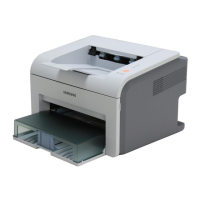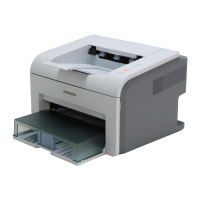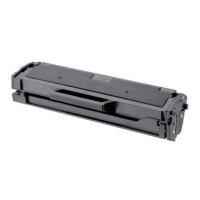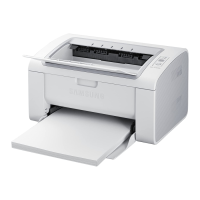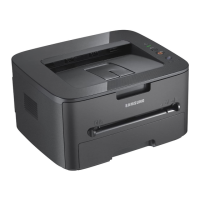
Do you have a question about the Samsung ML-2525W series and is the answer not in the manual?
| Print Technology | Laser |
|---|---|
| Print Speed | 24 ppm |
| Input Capacity | 250 sheets |
| Output Capacity | 100 sheets |
| Output Capacity (Alternative) | 100 sheets |
| Memory | 8 MB |
| Internal Memory | 8 MB |
| Dimensions (WxDxH) | 360 x 389 x 197 mm |
| Dimensions | 360 x 389 x 197 mm |
| Weight | 7.3 kg |
| Weight (Alternative) | 7.3 kg |
| Time to First Page | 8.5 s |
| First Page Out | 8.5 s |
| Connectivity | USB 2.0 |
| Wireless LAN | 802.11b/g |
| Supported Operating Systems | Windows, Mac OS, Linux |
| Warm-up Time | Less than 10 seconds |
Describes safe operating conditions and precautions to prevent injury or damage.
Details safe usage procedures to prevent damage or injury during operation.
Safety guidelines for setting up and relocating the machine to prevent hazards.
Safety precautions to follow during routine maintenance and checks.
Safety precautions related to the handling and use of consumables like toner.
Specific safety statement regarding laser radiation hazards and precautions.
Compliance with FCC and other radio regulations for emissions.
EU compliance statements and relevant directives for the product.
Highlights key printing and operational capabilities of the machine.
Details print resolution and speed specifications for high-quality output.
Information on supported media types, including various paper sizes and envelopes.
Features for producing professional-looking documents like watermarks and posters.
Features for efficiency, such as duplex printing and power saving.
Information on compatibility with different operating systems and interfaces.
Provides a visual and descriptive overview of the machine's components.
Diagram illustrating the front view of the printer with labeled parts.
Diagram illustrating the rear view of the printer with labeled ports.
Description of the control panel buttons and their functions.
Explains the meaning of LEDs and the functions of control panel buttons.
Step-by-step guide for the physical setup of the machine.
Procedure to print a test page to verify correct operation.
Information about the software included with the machine.
Lists necessary hardware and software for the machine's operation.
Guide for installing the printer driver via a USB connection.
Guide for installing the printer driver over a network connection.
Instructions for setting up the machine to be shared on a local network.
Details network requirements and supported protocols for connectivity.
Overview of software programs for managing network settings.
Instructions for connecting and configuring the machine via Ethernet.
Procedures for configuring static or dynamic IP addresses for the machine.
Explains connection types: Ad-Hoc and Infrastructure modes.
Steps to print the current network settings of the machine.
Information required for securing wireless network connections.
Guide for setting up an Ad-Hoc wireless connection on Windows.
Guide for setting up an Infrastructure wireless connection on Windows.
Steps to restore the machine's wireless network settings to defaults.
How to adjust settings for optimal print quality based on altitude.
Configuring the default paper tray and paper type for printing jobs.
How to activate and configure the power saving mode.
Guidelines for choosing and using appropriate print media.
Recommendations for selecting print media to avoid issues.
Instructions for adjusting the paper guides in the tray.
Detailed instructions for properly loading paper into the trays.
Information on printing various special media types like envelopes and labels.
Overview of software programs that assist with printing tasks.
Highlights standard and special features supported by the printer driver.
Fundamental steps required for printing documents from applications.
Accessing and modifying the printer's detailed settings.
Procedures to stop or remove print jobs from the queue.
Overview of advanced printing capabilities like N-up and poster printing.
How to print multiple document pages onto a single sheet of paper.
Adding text or images, like 'DRAFT' or 'CONFIDENTIAL', to documents.
Overview of software programs for managing the machine's functions.
Managing the printer via its embedded web service interface.
Configuring email alerts for machine status updates like toner levels.
Software for monitoring machine status and customizing settings.
Tool for configuring printer drivers and settings on Linux systems.
Managing and checking the status of available communication ports.
Printing a configuration page to view current printer settings.
Setting up notifications for low toner levels.
Instructions for cleaning the printer's interior and exterior to ensure optimal performance.
Detailed steps for cleaning internal components to resolve print quality issues.
Proper methods for storing toner cartridges to maintain quality.
Procedure to improve print quality by redistributing remaining toner.
Advice and steps to prevent paper from curling during printing.
Recommendations to prevent paper jams by selecting correct media and loading.
Step-by-step guide to safely remove jammed paper from the machine.
General guidance for resolving various common issues.
Troubleshooting specific issues related to paper not feeding correctly.
Solutions for common issues where the machine does not print.
Troubleshooting print quality defects like streaks, spots, or smudges.
Specific troubleshooting steps for issues encountered on Windows.
Specific troubleshooting steps for issues encountered on Linux.
Specific troubleshooting steps for issues encountered on Macintosh.
Information on ordering genuine consumables and maintenance parts.
List of consumables available for purchase for the machine.
List of maintenance parts that may need replacement over time.
Instructions for safely removing and installing the toner cartridge.
Details on the machine's physical dimensions, weight, and package.
Information on operating temperature, humidity, and noise levels.
Details on power requirements, voltage, and consumption.
Technical data on supported paper types, sizes, weights, and capacities.




